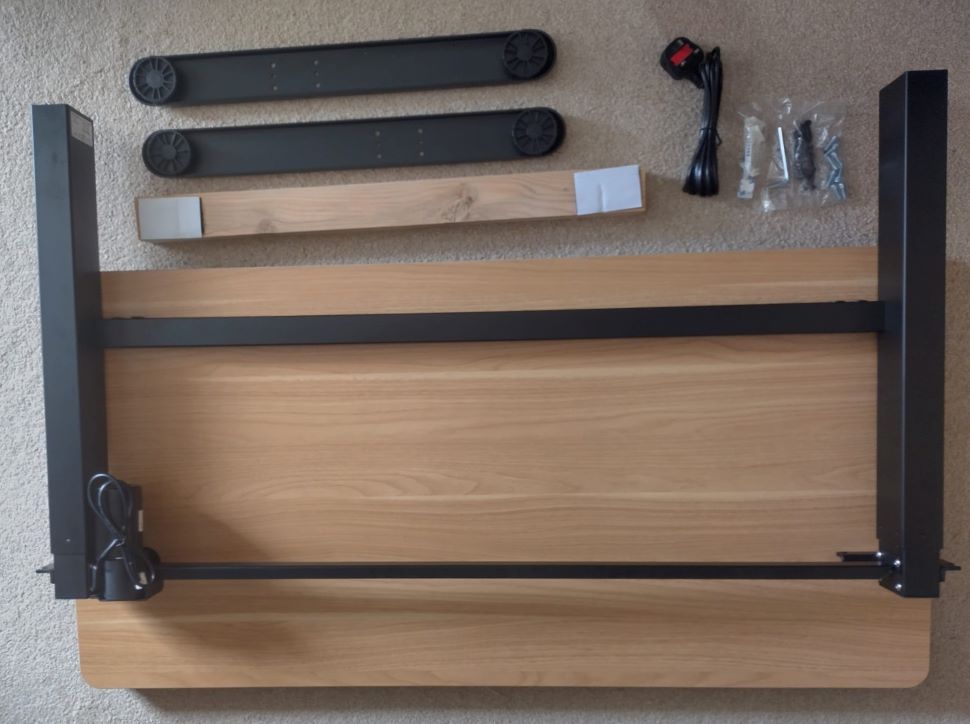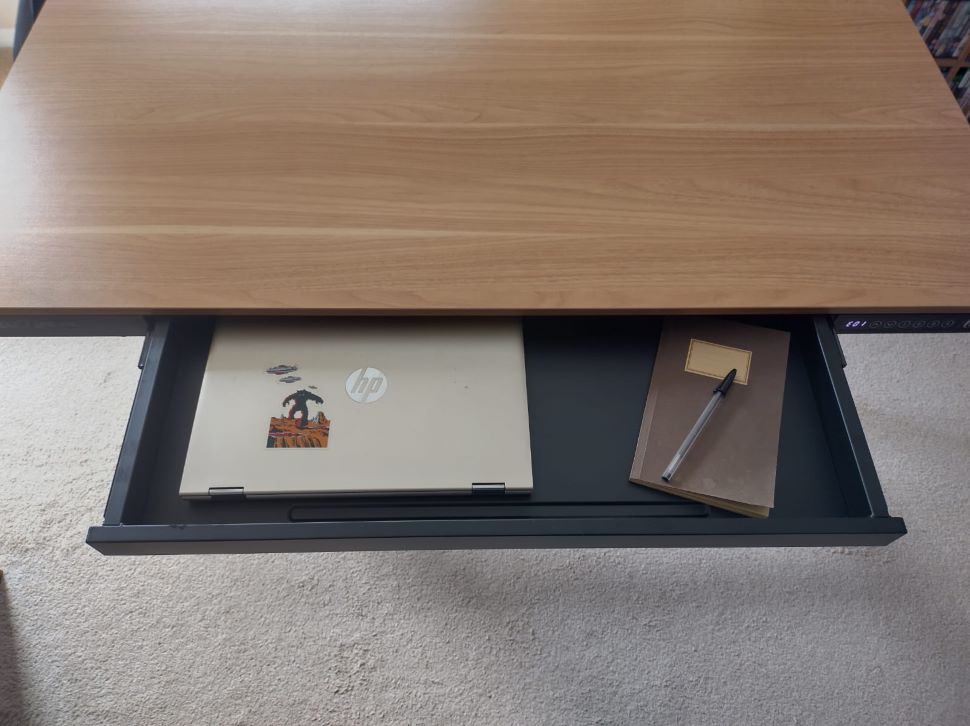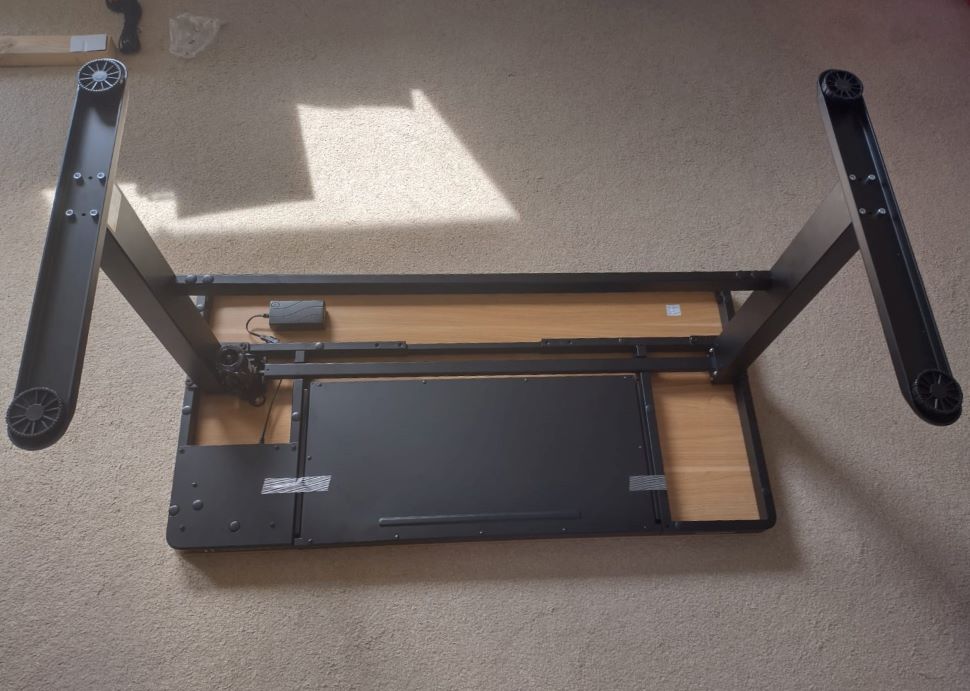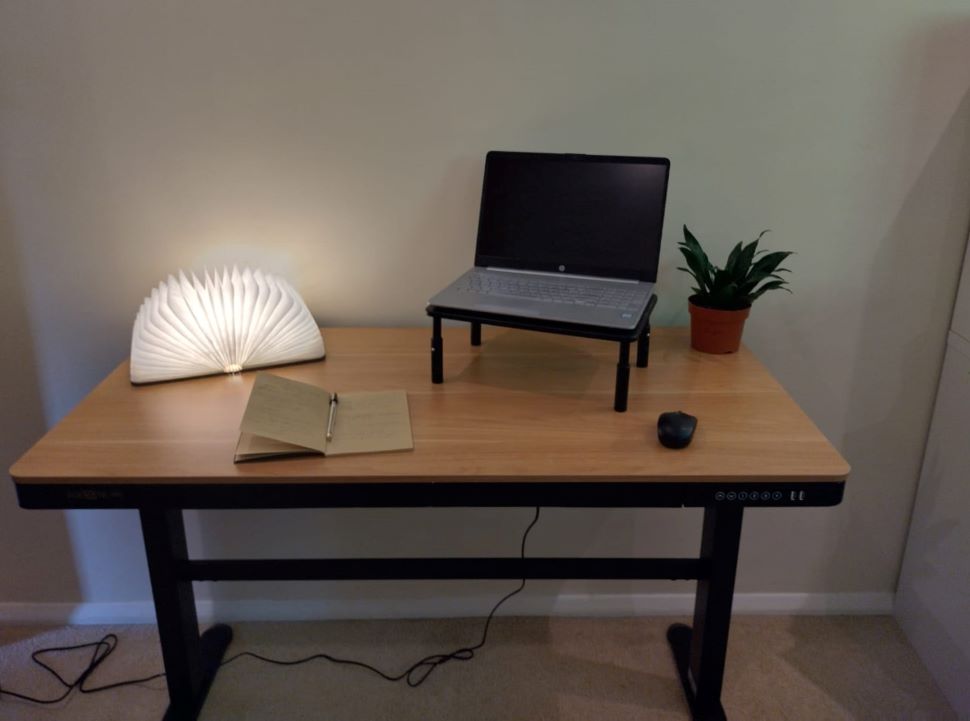TechRadar Verdict
The Elevate 120 electric sit-stand desk is a sturdy bit of kit that irons out a number of niggles you may find in other standing desks. The tabletop is spacious, accommodating dual monitor set-ups, and assembly is as easy as 1-2-3 - literally. It might lack a sharp design, but VisionAid’s adjustable workstation is ideal for home office workers looking for a broader height range.
Pros
- +
3-step assembly
- +
Everything included in box
- +
USB charging ports
- +
Sturdy build
- +
Lower sitting height
Cons
- -
No cable management tray
- -
Plain design
- -
UK-only delivery at present
Why you can trust TechRadar
The Elevate 120 sit-stand desk from VisionAid intends to plug a gap in the market. Currently, even the best standing desks generally have a high starting height of 72cm, rising to 120cm. Not ergonomically ideal for many (except, perhaps, manufacturers of footrests). Especially those with vision impairments, who find themselves hunched over desks to see the screen.
For VisionAid, a company that provides solutions for blind and partially sighted people, this was an issue that needed addressing. Based in the UK, the family-run business looked to refine one of the best sit-stand desks on the market.
Tabletop: 120 x 60cm
Height: 69cm to 117cm
User height: 5ft to 6ft 8”
Max screen size: 27ins
Weight: 44.5kgs
Taking the frame of the excellent FlexiSpot EG8 - which we called a “feature-packed electric standing desk with a unique look” in a review that earned it 4.5 stars - VisionAid and FlexiSpot owner Loctek retooled the EG8.
Modifying the height range is the first change. The lowest setting now keeps your desk at 69cm. To accommodate this, the maximum height is reduced to 117cm - providing comfort for users up to 6’8”. The horizontal support bar has also been raised, to stop it getting in the way of the users’ feet without impacting stability.
Essentially, VisionAid has created an accessible, inclusive standing desk experience for a broader range of users. It builds on the foundations of the FlexiSpot EG8 - particularly its easy, three-step assembly - but suffers some of the same minor gripes we had with that model.
- Best office chair: The verdict is in
What’s in the box?
Everything you need to build the Elevate 120 comes in the box. No digging around the toolbox for an oh-so-specific screwdriver here. Lift the lid to reveal:
- 1x tabletop
- 1x lifting column (legs)
- 2x feet
- 1x mains lead
- 1x wooden monitor support arm
- 16x socket screws
- 4x cable clamps
- 1x Allen/hex key

Design and build quality
The Elevate 120 has an uncomplicated design. Our review unit featured an oak top and black frame, although it’s also available in white or black matte, or with a glass top. Unlike the delicate frame of the Uplift V2 or eye-catching ApexDesk Elite, there’s no attractive curves and functional cut-outs. But it’s slim, modern, and minimalist, giving it broad appeal.
The desk’s build quality is simple and impressive. Everything has a suitable amount of hardiness and heft. The weight gives it a welcome sturdiness, but this is a heavy beast of a desk, and it’ll take two to lift into position.
A slim tabletop, spacious enough for a wide screen or dual monitor setup, is sturdy without losing its sleekness. It also features automatic collision detection, reversing direction if it senses an object in its path.
At the front, you’ll find a shallow drawer. Good for stashing your laptop and stationery, but not large enough to handle much more than that. A slim control box sits to the right. Here, you’ll find a three-digit screen, up and down buttons, and four customizable preset heights. The sit-stand desk also features two USB-A fast-charging ports and one USB-C port.

Flip the desk over - you’ll need to for assembly anyway - to find a power brick attached with velcro pads, the rear of the control box, and a discreet motor. Notable in its absence is a cable management tray, which might make it more appealing to laptop owners over desktop users.
Instead, four stick-on cable clamps take on the role of a more - ahem - flexible cable management here. It’s a fair workaround, but, like the wooden monitor support arm, isn’t in keeping with the desk’s otherwise premium feel.
Like the rest of the desk, the lifting column has the same confident weight to it. It's a single metal piece with support beams connecting two thick, rectangular legs. Whack ‘em and they make a sonorous thwock. This isn’t a desk you fear to lean on.
Assembly
Assembling the Elevate 120 is a three-step process. This is about as easy as standing desk assembly gets - the hardest part is lifting it into position, which isn’t a solo job. .
Grab the Allen key and the eight black socket screws. Line up the lifting column with the holes on the underside of the desktop, and screw the legs into place.

Next, attach the feet to the legs using the eight silver socket screws.
With the pieces bolted together, turn the desk the right way up. Connect the lead from the motor to the back of the control box. Hook up the mains lead to the power brick, and plug it in.

Job done - in about ten minutes. The instructions offered clear directions and illustrations, and we found none of the Ikea-style frustrations typically associated with self-assembly pieces. True, one of two screws needed an extra fiddle to ensure alignment, but nothing to concern even the most infrequent DIYer.
One of our first thoughts, given VisionAid’s emphasis on accessibility and independent living, was just how accessible the instructions could be. After all, a printed manual can be tricky for the best of us to read, even with a Sherlockian magnifying glass to hand.
So, we were warmed to see a step-by-step guide is also on VisionAid’s YouTube channel and as a PDF download available here. If you suffer vision impairments, this is an excellent way to access the manual in the best way for you.
Control
Elevation control is straightforward. Two arrow buttons let you move the desk along the vertical plane - it takes around 23 seconds to go from the lowest to highest setting, with ‘BOT’ or ‘TOP’ displays on the screen at these points. During operation, the readout shows the current elevation (in centimeters).
If you’re a stickler for an ultra-specific height, using these keys can be a tad difficult. Press too fast and nothing happens; press too long as the desk goes whirring up or down, so you’ll almost always be a few millimeters out. It’s a step up, however, from the original FlexiSpot EG8, which tended to continue traveling after the button was released.
The four memory presets come equipped with height settings, but it’s easy enough to switch these out to quickly move between sitting and standing, especially if you share the desk with others.
To do this, adjust the desk to your preferred height, then press and hold a preset button. They don’t click or otherwise offer feedback, but after about four seconds, the screen flashes with the preset number.
At the far right of the panel is the child-lock - a real click-click physical button that’s just as useful for those of us with the clumsy habit of accidentally knocking buttons. Activating the lock prevents height adjustment, and any attempt to raise or lower the desk results in a sharp bleep as the screen flashes ‘LOC’.

In use
Making good on its promise to offer a comfortable lower height setting, the Elevate 120 performs very well in use. We found the sound of the motor to be relatively hushed. It’s not exactly a whisper-quiet purr, but low decibel enough, even for nighttime use.
Raising and lowering the desk, traversal feels firm and confident. The desk ably passed the ‘coffee’ test - it didn’t spill a drop on descent or ascent. To prevent over-heating, the motor can be used for a maximum with two minutes, with an 18-minute cooldown.
Once we had it set up, we found the tabletop’s generous surface area is ideal for a broad range of tasks. This is pure workspace, without distractions or design flaws that break the flow. That size means, in smaller rooms, the standing desk is going to dominate the space.
We were impressed, too, with the USB charging ports. Once connected, the cable felt snug in the slot, and facilitated fast charging for our devices. The far-flung position of the ports means leads stay close at hand without getting in the way of your work (or the desk’s operation, for that matter).
Final verdict
The Elevate 120 is a simple, sleek, sturdy sit-stand desk that’s fuss-free from assembly to operation.
After a breezy three-step build process, performance is spot-on and satisfyingly easy to control, even if this is your first electric standing desk.
Broad deskspace allows for a range of set-ups, from gaming to WFH, if you have the space to accommodate it. And, ideally, the room to build the desk where it stands. Maneuvering tight hallways is tricky with your arms weighed down with this desk .
The Elevate is modern in that stripped-back minimalist fashion. True, the clean design may be a tad utilitarian for some. On the other hand, that gives you scope to make the deskspace your own. However, the bare aesthetic only serves to highlight the lack of built-in cable management, leaving unsightly, unwieldy vines drooping off the back.
Appearance isn’t a deal-breaker with a standing desk this accessible, though. With a lower resting sit height than many on the market, The Elevate 120 is perfect for those who find dangling off footrests a pain and ideal for anyone looking for home office essentials.
- Best scanners: Tested, reviewed, and rated for your home office

Steve is B2B Editor for Creative & Hardware at TechRadar Pro. He began in tech journalism reviewing photo editors and video editing software at Web User magazine, and covered technology news, features, and how-to guides. Today, he and his team of expert reviewers test out a range of creative software, hardware, and office furniture. Once upon a time, he wrote TV commercials and movie trailers. Relentless champion of the Oxford comma.
